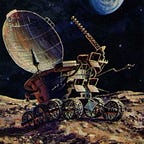Fourier Lab converts aerospace lens to cinema
I bought an interesting lens from Ukraine on eBay, that was used in USSR space program on a space satellite. The lens is called Leningrad-9.
The motivation was to convert the it to cinematic 35mm.
The description of the lens in Russian photo history museum:
Aero photography lens from a series of temperature-non-detuning — for cameras with a frame format of 30x30 cm. Field of view — 24°. Components / lenses — 4/4. Developed in 1956 under the direction of D.S. Volosov, and on April 26, 1962, the Kosmos-4 satellite launched photographic equipment equipped with a Leningrad-9 telephoto lens and an Orion-20 wide-angle topographic lens into low Earth orbit. The resolution was: center / edge, lines / mm — 40/20. Aperture limits 10–32. Weight — 8.5 kg.
http://www.photohistory.ru/1488295426944928.html
Technical drawing from 1956:
Google helped me to find some information about the spacecraft Zenit-2, which used to carry this lens to open space.
Source of the following passages:
In 1957, even before the launch of the first satellites, Sergei Korolev’s Special Design Bureau №1 (OKB-1) began research on the creation of an orbital photographic reconnaissance vehicle — the “object OD-1”. The project was handled by the sector of Evgeny Ryazanov. In the initial versions, the spacecraft consisted (like the Discoverer) of an instrument compartment and a return capsule. The instrument compartment housed photographic equipment, radio equipment and service systems. The cone-shaped return capsule contained film cassettes and equipment needed to facilitate its search after landing.
At the same time, the bureau was developing a manned spacecraft — the “object OD-2”. The project was led by a talented designer and future cosmonaut Konstantin Feoktistov. It was he who proposed to make the ship out of two parts separated in orbit: the instrument compartment and the spherical descent vehicle. In mid-August 1958, the Feoktistov group issued a report entitled “Materials for the preliminary study of the issue of creating an Earth satellite with a man on board.” It proved that with the help of a three-stage carrier built on the basis of the R-7A intercontinental rocket, a ship weighing from 4.5 to 5.5 tons could be launched into space.
On September 15, Korolev signed the report and the next day sent letters to the management notifying him of the completion of research, allowing him to begin developing a “reconnaissance satellite carrying a person on board” . At a meeting of the Council of Chief Designers, held in November, reports were heard on three projects: an automatic photo reconnaissance vehicle, a rocket vehicle for human flight along a suborbital trajectory, and a manned orbital spacecraft. After discussion, the last project was chosen as a priority, although representatives of the Ministry of Defense insisted that preference should be given to the photo reconnaissance.
Realizing that you still can’t do without military customers, Korolev showed political flexibility — at the beginning of 1959, he proposed to unify the systems of the ship and photo reconnaissance in a single project under the code “Vostok”. Since they were going to use sophisticated expensive photographic equipment for reconnaissance, the option arose to place it in the descent vehicle instead of the pilot, returning it to Earth along with the captured films. Of course, this decision required the complete automation of the ship, which Korolev was quite happy with — in manned flights, he was going to reduce the influence of the human factor to a minimum. The photo reconnaissance aircraft was taken into development under the name Vostok-2. To avoid confusion, it was later renamed Zenit-2.
March 10, 1964, the Zenit-2 rocket and space complex was adopted by the Soviet army. For the first time in history, a complex system, including a launch vehicle and a large photo-reconnaissance satellite with a re-entry vehicle, was placed at the disposal of the troops to carry out the operational tasks of the command. At that time, few people knew that Zenit-2 was a modification of the Vostok spacecraft, on which Yuri Gagarin paved the “road to the stars.”
Zenit 2
Photo reconnaissance “Zenit-2”: 1 — photographic equipment; 2 — descent vehicle; 3 — cylinders of the orientation system; 4 — instrument compartment; 5 — antennas of telemetry systems; 6 — brake propulsion system; 7 — solar orientation sensor; 8 — vertical builder; 9 — program radio link antenna; 10 — antenna of the radio intelligence system.
Kosmos-4 is similar satellite to Vostok, which is described below:
The camera systems were built into the spherical reentry capsule of a Vostok spacecraft. The return capsule had a diameter of 2.3 meters and a launch weight of 2,400 kilograms.
The entire spacecraft had a length of around 5.0 meters and a weight of 4600–4740 kilograms.
The equipment usually included four cameras with a 1000 millimeter focal length and one with a 200 millimeter focal length. The latter camera should provide overview images with a lower resolution. The others provided images on photographic film covering areas of 60x60 kilometers from an altitude of 200 kilometers. The resolution was thought to be in the range of 10–15 meters to begin with, but may have been so good that it was possible to count cars in a car park. Zenit 2 could also carry equipment for electronic reconnaissance (see space operations ). Exposed film was taken down to the ground in the spacecraft’s re-entry section. This method differs from the American Corona- the program’s use of smaller return capsules. Removal of a larger return section or smaller capsules was later replaced by systems for electronic transfer of the images.
First image captures by R3 sensor at fully closed aperture.
The trees are around 1 mile away.
